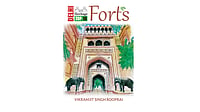Nur Jahan—we know her as the empress who had Jehangir besotted, the daughter of a Persian noble who had been married before, but who somehow managed to capture the Mughal’s fickle heart from among the thousand women who vied for his royal attention in his harem. Nur Jahan was undoubtedly beautiful—there are ample records of that along with snide comments on how she encouraged Jehangir’s substance abuse, from foreign travellers who never quite understood Mughal purdah systems and, in Nur Jehan’s case, the lack of them.
Lal proceeds to demonstrate how Nur Jahan dominated most women of her time by opening her narrative with a tiger hunt. Villagers being ravaged by a man-eating tiger had begged the emperor to rescue them. Jehangir, who had sworn off hunting, passed the task to his consort who, from the back of a panicked elephant, shot the tiger neatly between the eyes. This tiger queen was more than just a seductive beauty, says Lal.
Nur Jahan, we hear, was an able ruler who fought for her underprivileged subjects. She was also one of Jehangir’s harem—she was moved there after the death of her husband, Ali Quli, who rebelled against Jehangir. The mystery is how, among so many, she was able to take Jehangir by a coup de foudre. If he had met her before her marriage and lost his heart to her, there would be some logic to it. However, those stories of a naive young beauty freeing rare pigeons have no authenticity. She appears in Jehangir’s writings fairly late, after she had established her position and was far from naive.
Lal’s narrative depends on the records made available to her and these are not always complete—the result is breaks in the flow, which require the reader to guess why Nur Jahan and Shah Jahan fell out after an auspicious start—the shrewd power-broker she describes would certainly have been more cautious.
Empress has a broad sweep of canvas, covering the intricate court politics of the time. Nur Jahan, once married to Jehangir and issuing coins in her own name, became an integral part of the royal game. Lal talks about the marriages that Nur Jahan arranged for orphan girls and for the older women known as sahelis and adds that Nur Jahan even devised an economical wedding dress design for them that is still worn today. She was also an architect and poet—in short, the ‘Light of the World’ was the light of perfection. If she had flaws, they presumably lay in her ambitions to control the empire through a son-in-law after Jehangir passed on and that triggered her downfall and her reputation in the eyes of history.
Nur Jahan’s near-absolute power did not survive her husband’s death and nor, despite the fact that she was given the title Padshah, did she attempt to take over the throne in her own right—a remarkable thing in itself. Ruby Lal tells her story in an accomplished, even tone with poetic touches, though a glint of Nur Jahan’s charm from time to time would have been very welcome.


























